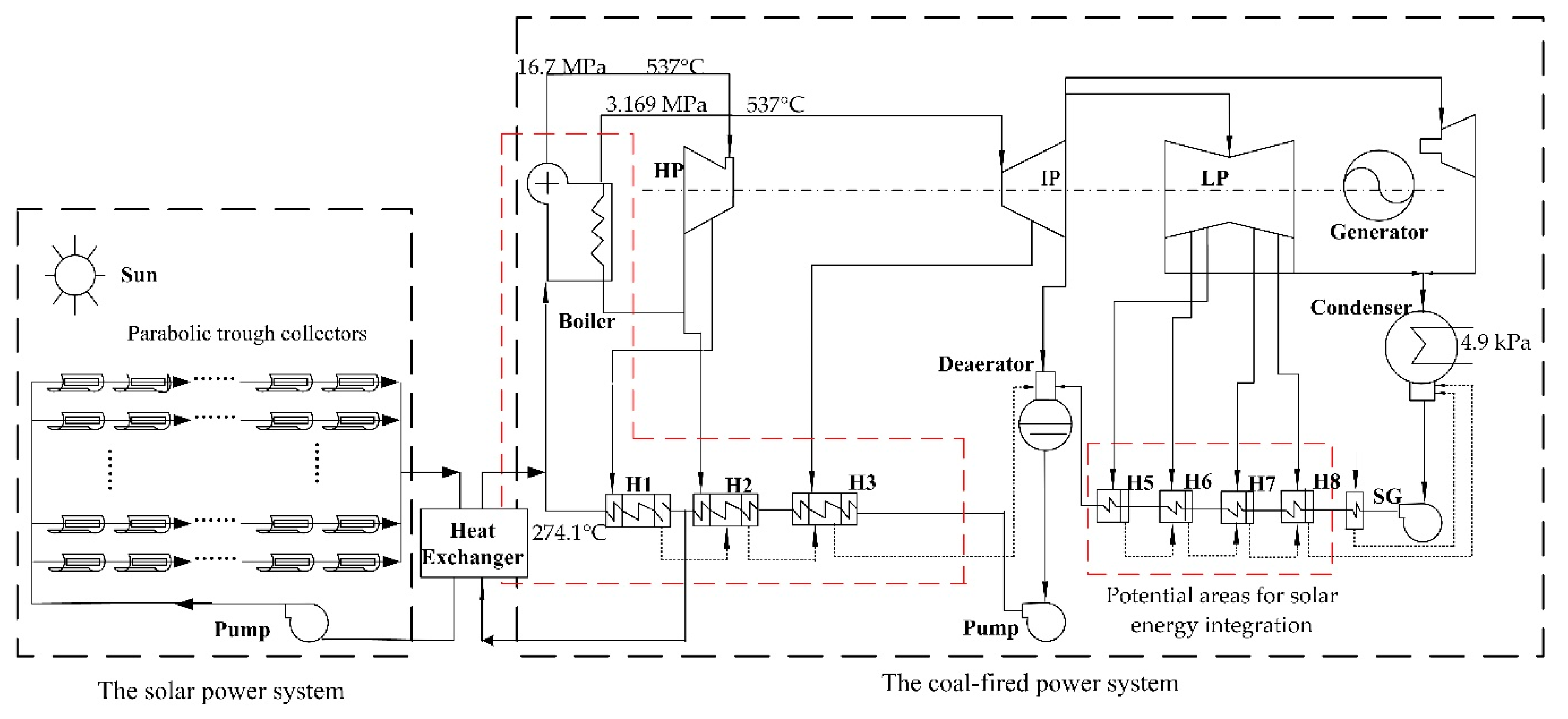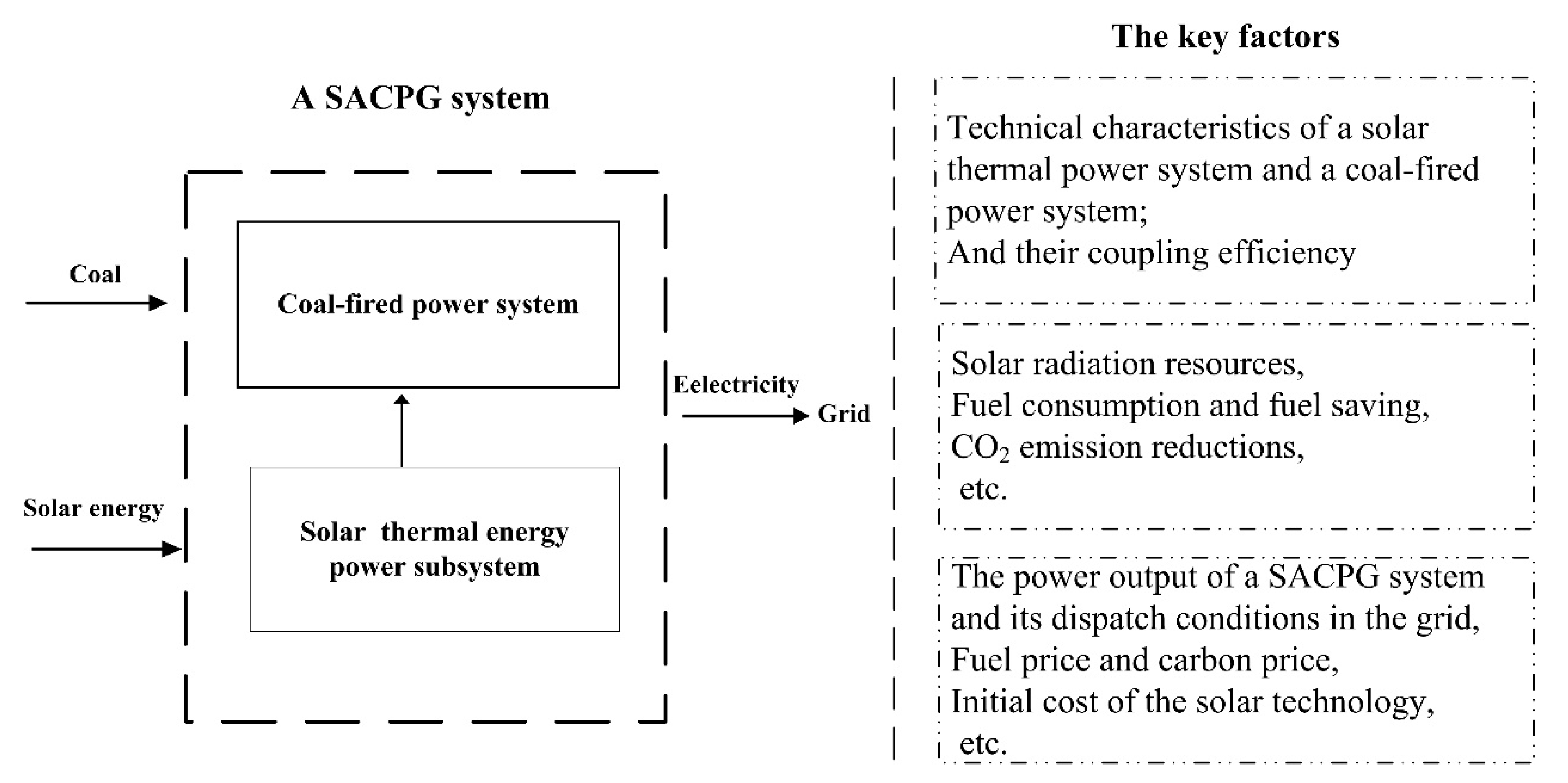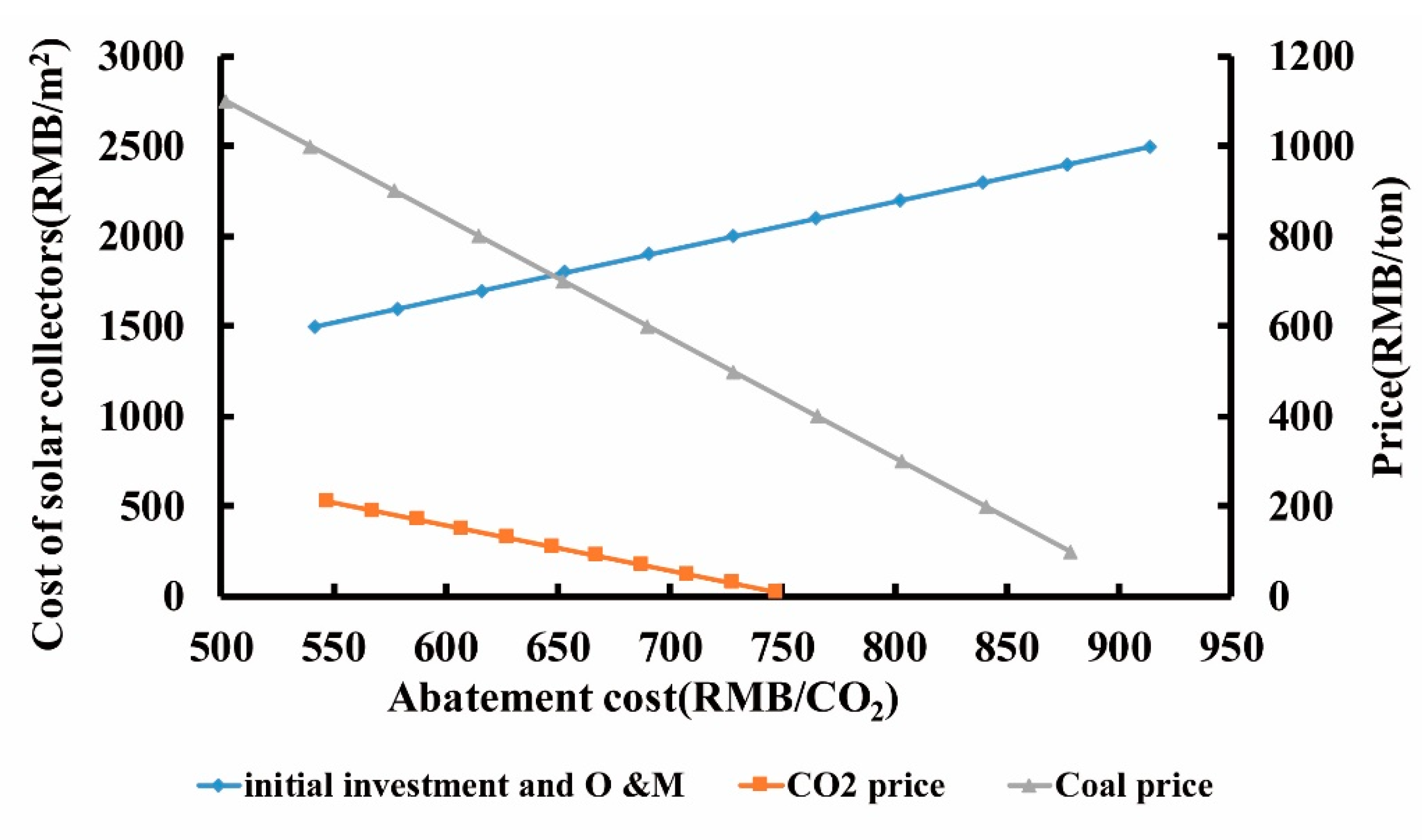Analysis of CO2 Abatement Cost of Solar Energy Integration in a Solar-Aided Coal-Fired Power Generation System in China
Abstract
1. Introduction
2. Description of a SACPG System and Its Key Factors
2.1. SACPG Description
2.2. Key Factors for a SACPG System
3. Methodology of a SACPG System and Qualitative Analysis of Its Key Factors
3.1. Modeling of the Abatement Cost of a SACPG System
3.1.1. Baseline Determination of Energy Saving and CO2 Emission Reductions
3.1.2. Analysis Model of CO2 Abatement Cost for a SACPG System
3.2. Qualitative Analysis of the Key Factors on Carbon Abatement Cost of a SACPG System
3.2.1. Coupling Effect Analysis of ηcoe(Qabs) and ηso,SACPG(Qabs)
3.2.2. Analysis of Solar Energy Resource
3.2.3. Analysis of the Key Economic Factors
4. Case Study
4.1. Description of the Case
4.2. Results and Discussions
4.2.1. Coupling Effect of Solar Integration Schemes on CO2 Abatement Cost
4.2.2. The Effect of Solar Energy Resource on CO2 Abatement Cost
4.2.3. The Effects of Key Economic Factors on the Abatement Cost
4.2.4. Further Analyses and Discussion
5. Conclusions
Author Contributions
Funding
Acknowledgments
Conflicts of Interest
Appendix A. The Levelized Electricity Generation Cost of a SACPG System
References
- Mitchell, C. Momentum is increasing towards a flexible electricity system based on renewables. Nat. Energy 2016, 1, 15030. [Google Scholar] [CrossRef]
- Davidson, M.; Zhang, D.; Xiong, W.; Zhang, X.; Karplus, V.J. Modelling the potential for wind energy integration on China’s coal-heavy electricity grid. Nat. Energy 2016, 1, 16086. [Google Scholar] [CrossRef]
- The National Development and Reform Commission (NDRC), National Energy Administration (NEA), Several Opinions on Speeding up the Shutdown of Small Thermal Power Units. Available online: http://www.gov.cn/zwgk/2007-01/26/content_509911.htm (accessed on 25 May 2019).
- The National Development and Reform Commission (NDRC), National Energy Administration (NEA), etc., Energy-Saving Power Generation Dispatching Method (Trial). Available online: http://www.gov.cn/gongbao/content/2007/content_744115.htm (accessed on 25 May 2019).
- Wu, J.; Hou, H.; Yang, Y.; Hu, E. Annual performance of a solar aided coal-fired power generation system (SACPG) with various solar field areas and thermal energy storage capacity. Appl. Energy 2015, 157, 123–133. [Google Scholar] [CrossRef]
- Wu, J.; Hou, H.; Yang, Y. Annual economic performance of a solar-aided 600 MW coal-fired power generation system under different tracking modes, aperture areas, and storage capacities. Appl. Therm. Eng. 2016, 104, 319–332. [Google Scholar] [CrossRef]
- Zhu, Y.; Zhai, R.; Zhao, M.; Yang, Y.; Yan, Q. Evaluation methods of solar contribution in solar aided coal-fired power generation system. Energy Convers. Manag. 2015, 102, 209–216. [Google Scholar] [CrossRef]
- Peng, S.; Hong, H.; Wang, Y.; Wang, Z.; Jin, H. Off-design thermodynamic performances on typical days of a 330MW solar aided coal-fired power plant in China. Appl. Energy 2014, 130, 500–509. [Google Scholar] [CrossRef]
- Zhao, Y.; Hong, H.; Jin, H. Evaluation criteria for enhanced solar–coal hybrid power plant performance. Appl. Therm. Eng. 2014, 73, 577–587. [Google Scholar] [CrossRef]
- Zhao, Y.; Hong, H.; Jin, H. Mid and low-temperature solar–coal hybridization mechanism and validation. Energy 2014, 74, 78–87. [Google Scholar] [CrossRef]
- The Institute of Electrical Engineering (IEE) of Chinese Academy of Sciences (CAS), Opinions and Suggestions on the Incentive Policies and Measures to Accelerate the Development of China’s Domestic Photovoltaic Market. Available online: https://www.efchina.org/Reports-zh/reports-efchina-20090530-zh (accessed on 27 May 2019).
- Zhu, Y.; Zhai, R.; Qi, J.; Yang, Y.; Reyes-Belmonte, M.; Romero, M.; Yan, Q. Annual performance of solar tower aided coal-fired power generation system. Energy 2017, 119, 662–674. [Google Scholar] [CrossRef]
- Pavlović, T.M.; Radonjic, I.; Milosavljević, D.D.; Pantic, L.S. A review of concentrating solar power plants in the world and their potential use in Serbia. Renew. Sustain. Energy Rev. 2012, 16, 3891–3902. [Google Scholar] [CrossRef]
- Khan, J.; Arsalan, M. Solar power technologies for sustainable electricity generation—A review. Renew. Sustain. Energy Rev. 2016, 55, 414–425. [Google Scholar] [CrossRef]
- Jamel, M.; Rahman, A.A.; Shamsuddin, A. Advances in the integration of solar thermal energy with conventional and non-conventional power plants. Renew. Sustain. Energy Rev. 2013, 20, 71–81. [Google Scholar] [CrossRef]
- Yang, Y.; Cui, Y.; Hou, H.; Guo, X.; Yang, Z.; Wang, N. Research on solar aided coal-fired power generation system and performance analysis. Sci. China Ser. E Technol. Sci. 2008, 51, 1211–1221. [Google Scholar] [CrossRef]
- Tora, E.; El-Halwagi, M.M. Optimal design and integration of solar systems and fossil fuels for sustainable and stable power outlet. Clean Technol. Environ. Policy 2009, 11, 401–407. [Google Scholar] [CrossRef]
- Larraín, T.; Escobar, R.; Vergara, J. Performance model to assist solar thermal power plant siting in northern Chile based on backup fuel consumption. Renew. Energy 2010, 35, 1632–1643. [Google Scholar] [CrossRef]
- Yan, Q.; Yang, Y.; Nishimura, A.; Kouzani, A.; Hu, E. Multi-point and Multi-level Solar Integration into a Conventional Coal-Fired Power Plant. Energy Fuels 2010, 24, 3733–3738. [Google Scholar] [CrossRef]
- Yan, Q.; Hu, E.; Yang, Y.; Zhai, R.-R. Evaluation of solar aided thermal power generation with various power plants. Int. J. Energy Res. 2010, 35, 909–922. [Google Scholar] [CrossRef]
- Yang, Y.; Yan, Q.; Zhai, R.-R.; Kouzani, A.; Hu, E. An efficient way to use medium-or-low temperature solar heat for power generation—Integration into conventional power plant. Appl. Therm. Eng. 2011, 31, 157–162. [Google Scholar] [CrossRef]
- Zhao, J. Analysis of Solar Aided Steam Production in a Pulverized Coal Boiler. In Proceedings of the 2011 Asia-Pacific Power and Energy Engineering Conference, Wuhan, China, 25–28 March 2011. [Google Scholar]
- Reddy, V.S.; Kaushik, S.C.; Tyagi, S.K. Exergetic analysis of solar concentrator aided coal fired super critical thermal power plant (SACSCTPT). Clean Technol. Environ. Policy 2012, 15, 133–145. [Google Scholar] [CrossRef]
- Gupta, M.; Kaushik, S.; Ranjan, K.; Panwar, N.L.; Reddy, V.S.; Tyagi, S. Thermodynamic performance evaluation of solar and other thermal power generation systems: A review. Renew. Sustain. Energy Rev. 2015, 50, 567–582. [Google Scholar] [CrossRef]
- Hou, H.; Wu, J.; Yang, Y.; Hu, E.; Chen, S. Performance of a solar aided power plant in fuel saving mode. Appl. Energy 2015, 160, 873–881. [Google Scholar] [CrossRef]
- Lozano, M.; Valero, A. Theory of the exergetic cost. Energy 1993, 18, 939–960. [Google Scholar] [CrossRef]
- Yang, M.-H.; Yeh, R.-H. Thermo-economic optimization of an organic Rankine cycle system for large marine diesel engine waste heat recovery. Energy 2015, 82, 256–268. [Google Scholar] [CrossRef]
- Peng, S.; Wang, Z.; Hong, H.; Xu, D.; Jin, H. Exergy evaluation of a typical 330MW solar-hybrid coal-fired power plant in China. Energy Convers. Manag. 2014, 85, 848–855. [Google Scholar] [CrossRef]
- Hong, H.; Peng, S.; Zhang, H.; Sun, J.; Jin, H. Performance assessment of hybrid solar energy and coal-fired power plant based on feed-water preheating. Energy 2017, 128, 830–838. [Google Scholar] [CrossRef]
- Hong-Juan, H.; Zhen-Yue, Y.; Yong-Ping, Y.; Si, C.; Na, L.; Junjie, W. Performance evaluation of solar aided feedwater heating of coal-fired power generation (SAFHCPG) system under different operating conditions. Appl. Energy 2013, 112, 710–718. [Google Scholar] [CrossRef]
- Zhang, M.; Xu, C.; Du, X.; Amjad, M.; Wen, D. Off-design performance of concentrated solar heat and coal double-source boiler power generation with thermocline energy storage. Appl. Energy 2017, 189, 697–710. [Google Scholar] [CrossRef]
- Zhu, Y.; Zhai, R.-R.; Peng, H.; Yang, Y. Exergy destruction analysis of solar tower aided coal-fired power generation system using exergy and advanced exergetic methods. Appl. Therm. Eng. 2016, 108, 339–346. [Google Scholar] [CrossRef]
- Zhai, R.; Yang, Y.; Zhu, Y.; Chen, D. The Evaluation of Solar Contribution in Solar Aided Coal-Fired Power Plant. Int. J. Photoenergy 2013, 2013, 1–9. [Google Scholar] [CrossRef]
- Beretta, G.; Iora, P.; Ghoniem, A.F. Allocating electricity production from a hybrid fossil-renewable power plant among its multi primary resources. Energy 2013, 60, 344–360. [Google Scholar] [CrossRef]
- Zhao, J.; Yang, K. Allocating Output Electricity in a Solar-Aided Coal-Fired Power Generation System and Assessing Its CO2 Emission Reductions in China. Sustainability 2020, 12, 673. [Google Scholar] [CrossRef]
- Zhai, R.-R.; Peng, P.; Yang, Y.; Zhao, M. Optimization study of integration strategies in solar aided coal-fired power generation system. Renew. Energy 2014, 68, 80–86. [Google Scholar] [CrossRef]
- Suresh, M.; Reddy, K.S.; Kolar, A.K. 4-E (Energy, Exergy, Environment, and Economic) analysis of solar thermal aided coal-fired power plants. Energy Sustain. Dev. 2010, 14, 267–279. [Google Scholar] [CrossRef]
- Zhai, R.-R.; Zhu, Y.; Yang, Y.; Tan, K.; Hu, E. Exergetic and Parametric Study of a Solar Aided Coal-Fired Power Plant. Entropy 2013, 15, 1014–1034. [Google Scholar] [CrossRef]
- Popov, D. An option for solar thermal repowering of fossil fuel fired power plants. Sol. Energy 2011, 85, 344–349. [Google Scholar] [CrossRef]
- Reddy, V.S.; Kaushik, S.; Ranjan, K.; Tyagi, S. State-of-the-art of solar thermal power plants—A review. Renew. Sustain. Energy Rev. 2013, 27, 258–273. [Google Scholar] [CrossRef]
- The International Energy Agency (IEA), Nuclear Energy Agency (NEA), Projected Costs of Generating Electricity. Available online: https://webstore.iea.org/download/direct/744?fileName=ElecCost2015.pdf (accessed on 27 May 2020).
- Manzolini, G.; Bellarmino, M.; Macchi, E.; Silva, P. Solar thermodynamic plants for cogenerative industrial applications in southern Europe. Renew. Energy 2011, 36, 235–243. [Google Scholar] [CrossRef]
- Morin, G.; Dersch, J.; Platzer, W.; Eck, M.; Häberle, A. Comparison of Linear Fresnel and Parabolic Trough Collector power plants. Sol. Energy 2012, 86, 1–12. [Google Scholar] [CrossRef]
- Yang, Y.; Guo, X.; Wang, N. Power generation from pulverized coal in China. Energy 2010, 35, 4336–4348. [Google Scholar] [CrossRef]
- Standardization Administration; etc., The Norm of Energy Consumption Per Unit Product of General Coal-Fired Power Set. Available online: http://www.cspress.com.cn/biaozhunziliao/1553.html (accessed on 11 May 2019).
- Standardization Administration; etc., The Norm of Energy Consumption Per Unit Product of Combined Heat and Power Generation. Available online: http://www.cspress.com.cn/biaozhunziliao/40862.html (accessed on 12 May 2019).
- Huang, X. Curriculum Design of Thermal Power Plant; China Electric Power Press: Beijing, China, 2002; pp. 88–91. [Google Scholar]
- Dudley, V.E.; Kolb, G.; Mahoney, A.R.; Mancini, T.R.; Matthews, C.W.; Sloan, M.; Kearney, D. Test Results: SEGS LS-2 Solar Collector. Other Information: PBD: December 1994. Available online: https://www.osti.gov/servlets/purl/70756 (accessed on 11 October 2019).
- Zhang, Y. Research on Solar-Coal Hybrid Electricity Generation System. Master’s Thesis, North China Electric Power University, Beijing, China, 20 December 2007. [Google Scholar]







| Item | Unit | H1 | H2 | H3 | H5 | H6 | H7 | H8 |
|---|---|---|---|---|---|---|---|---|
| Extraction pressure | MPa | 5.89 | 3.593 | 1.612 | 0.305 | 0.13 | 0.0697 | 0.022 |
| Extraction temperature | °C | 380.9 | 316.9 | 429.1 | 233.2 | 137.8 | 88.5 | 61 |
| Outlet temperature | °C | 274.1 | 242.3 | 199.3 | 129.6 | 102.9 | 85.7 | 58.2 |
| Drain water temperature | °C | 247.8 | 204.8 | 174.1 | 108.4 | 91.2 | 63.7 | 38.26 |
| Extraction coefficient | - | 0.07289 | 0.08286 | 0.03833 | 0.03497 | 0.02203 | 0.03402 | 0.03058 |
| Item | Unit | Value |
|---|---|---|
| Capacity of coal-fired system | MW | 600 |
| Main stream of coal-fired system | t/h | 1848.84 |
| Designed net coal consumption rate of the baseline unit | g/kWh | 322.9 |
| Designed DNI | W/m2 | 800 |
| Solar collector field area | m2 | 148,140 |
© 2020 by the authors. Licensee MDPI, Basel, Switzerland. This article is an open access article distributed under the terms and conditions of the Creative Commons Attribution (CC BY) license (http://creativecommons.org/licenses/by/4.0/).
Share and Cite
Zhao, J.; Yang, K. Analysis of CO2 Abatement Cost of Solar Energy Integration in a Solar-Aided Coal-Fired Power Generation System in China. Sustainability 2020, 12, 6587. https://doi.org/10.3390/su12166587
Zhao J, Yang K. Analysis of CO2 Abatement Cost of Solar Energy Integration in a Solar-Aided Coal-Fired Power Generation System in China. Sustainability. 2020; 12(16):6587. https://doi.org/10.3390/su12166587
Chicago/Turabian StyleZhao, Jun, and Kun Yang. 2020. "Analysis of CO2 Abatement Cost of Solar Energy Integration in a Solar-Aided Coal-Fired Power Generation System in China" Sustainability 12, no. 16: 6587. https://doi.org/10.3390/su12166587
APA StyleZhao, J., & Yang, K. (2020). Analysis of CO2 Abatement Cost of Solar Energy Integration in a Solar-Aided Coal-Fired Power Generation System in China. Sustainability, 12(16), 6587. https://doi.org/10.3390/su12166587




